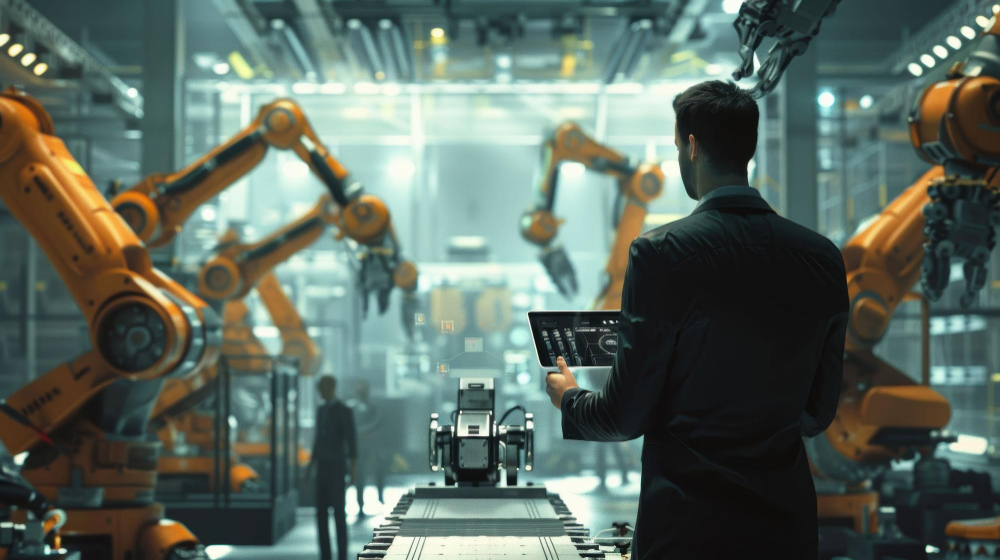- Blog
- December 9, 2022
2023 Top technology trends expected in the world of Manufacturing.

- Blog
- December 9, 2022
2023 Top technology trends expected in the world of Manufacturing.
Despite supply constraints, a manpower deficit, and an unstable economic climate, the manufacturing sector continues to outperform compared to prior years. Over the past few years, manufacturers have expanded their digital investment and hastened the adoption of emerging technology. Companies have a higher level of digital maturity and trying to expedite their digitalization of business processes. They continue to invest in cutting-edge manufacturing technologies that can aid in creating the necessary agility.
Manufacturers have expanded their digital investment and hastened the adoption of emerging technology. 2023 expects new trends to be in demand. Find them now.
In this blog article, we have listed the top technology trends that are expexted to dominate the manufacturing industry in 2023. Let us look at them as follows
- Predictive maintenance: Recent developments in artificial intelligence (AI), machine learning, and natural language processing (NLP) have enabled manufacturers to extract unstructured data from various documentation sources such as word, excel, powerpoint, etc , and turn it into a format that is useful for prediction engines. Predictive maintenance uses data analysis to discover irregularities in equipment performance and establish their fundamental cause. In its simplest form, predictive maintenance enhances the possibility that a problem will be adequately resolved on the first try, allowing manufacturers to improve equipment efficiency, cut costs, and increase first-time repair rates. Predictive maintenance will also enable systems to assist humans and identify good from bad production cycles based on machine data as it fluctuates among runs. One prediction said that between 2022 and 2030, the predictive maintenance market will expand at a CAGR of 27.4% and reach USD 64.25 billion. In 2023, it would be great to see how predictive maintenance play a game-changing role in the world of manufacturing.
- DigitalTwin:Digital twins will be present on up to 89% of IoT platforms by 2025. A depiction of a real-world system, procedure, or asset known as a “digital twin” can improve business applications. It assists in minimizing production utility maintenance and reducing total downtime. It creates a real-time synergy between the physical and virtual worlds when used in a production context. A consistent supply of real-world data will be available from the sensors installed to evaluate machine performance and environmental variables like humidity and ambient temperature. This data can then be integrated with information from other sources, such as CAD models. As a result, more manufacturing companies adopt the digital twin to accelerate market growth. Digitial Twin has been an exciting trend to watch. 2023 would hold its promise for sure.
- Robotic process automation (RPA): In the manufacturing industry, 25 percent of the workforce is over 55. RPA provides a low-risk alternative that uses software to support such aging existing staff. Bots can undertake repetitive jobs such as processing transactions or tying up invoices and payments, freeing employees to handle more important ones. A happy, more fulfilling workplace is ensured by assigning workers important work and letting robots do the menial jobs. In 2023, it is anticipated that the global robotic process automation (RPA) market will reach more than 41 billion US dollars.
- Cobot:Collaborative robots use less space since they can work side by side with human operators without physical separation, unlike typical industrial robots that require physical fences. Because of their affordability, portability, usability, adaptability, and low power requirements, collaborative robots(also known as cobots) are becoming excellent choices for small and medium-sized businesses (SMEs). Cobot adoption is anticipated to increase over the next 20 years as major corporations attempt to reintroduce human labor to manufacturing. In many different industries, including the production of automobiles, food and beverage, electronics, and hospitality, cobots have the ability to do various tasks, including packing, palletizing, machine tending, and quality inspection. The industrial cobot market valued at USD 866 million in 2022. But now, it is predicted to grow to USD 1661.4 million by 2028, at a CAGR of 11.5% over the forecast period of 2022–2028. Manufacturers would certainly want to know how Cobot can add value and innovate their business in 2023.
- Cloud-based ERP solution:A cloud-based ERP solution can assist businesses in smoothly integrating all facets of their manufacturing processes. All information is conveniently located in one place, easily accessible to anyone with the necessary permissions. Data, including stock amount levels, production plans, quality control inspections, and workflow, give businesses a complete picture of all aspects of their operations at a single point. The way operations are carried out can be improved by this integration and overview. It enables the use of new insights to streamline the process and make wise judgments going forward. In 2023, Big or small manufacturing businesses will increasingly rely on cloud-based ERP systems to address security flaws and reduce expenses by paying only for consumption. This also means, many manufacturing firms operating with on-prem ERP systems would look to go cloud.
- Big data: Because of the variety and depth of the products, the manufacturing sector is complex. Companies can use big data to handle the various data generated in the businesses from the event, such as building new factories in new areas and shifting production to other locations. New standards for information privacy and sharing, updating, transferring, searching, querying, and visualizing are emerging as a new way of collecting and keeping data changes. Big data refers to the vast amounts of structured and unstructured data that are regularly stored. Additionally, businesses employ the Big data analytics technique to look at industry trends, undiscovered patterns, and other valuable data that aids in making smart business decisions. In 2023, Big data technologies would be in demand by manufacturers to lead an insights-led business model.
Bottom line:
The Manufacturing industry is currently dealing with concerns about inflation and the state of the economy. Additionally, talent issues are still a problem for manufacturers and could slow the industry’s expansion. Supply chain problems, including sourcing bottlenecks, backlogs in global logistics, cost constraints, cyberattacks, etc. will probably continue to be major obstacles in 2023.
On the other hand, by going with these tech trends, manufacturers will defy the odds, aggressively pursue expansion initiatives, and promote the best possible business outcomes in 2023. As a result, the factories of the future will certainly turn out to be smart. The production process will be fully automated through the adoption of technologies, going beyond the basic automation found in earlier factories. The internet of things, virtual and augmented reality and artificial intelligence will all be used in the new manufacturing paradigm, which is fully connected, flexible, and more efficient. We are starting to witness this development in action already.
Technologies in manufacturing will lower labor costs, boost productivity, and cut waste, making future factories more affordable and environmentally benefitial. Furthermore, better quality control will guarantee top-notch goods that will benefit both buyers and manufacturers.




